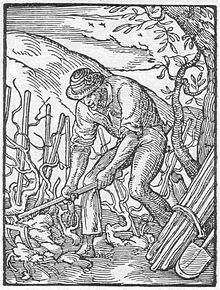Karst (tool)

Numerous hoe blade and karst types (below), Centro Etnográfico de Soutelo de Montes , Pontevedra
The karst , also two- / three-toothed , locally also hoe , is a tool with two (more rarely also three) stable prongs which are bent at right angles and which is derived from the hoe (hoe) .
Use, history and designs
So that you can also work with striking, the handle is not held in a spout, but rather like a hatchet in a forged house.
The karst was already used in ancient times to loosen the soil and harvest field crops. It was used in the Middle Ages as a handover symbol when awarding peasant goods and was considered a symbol of the peasant class until the twentieth century .
Heraldry: The Karst as a coat of arms
A red karst on the left in the coat of arms of Hochheim am Main , Main-Taunus-Kreis
Coat of arms of the municipality of Karsdorf , Burgenlandkreis
See also
- Krail , usually with four prongs, less robust and designed more for pulling than cutting work.
Web links
Commons : Hacken (Hauen, Karste) - collection of pictures, videos and audio files
- Catalog with approx. 90 different designs by Hacken, Karsten and others , SHW Friedrichstal (PDF file; 2.1 MB)










